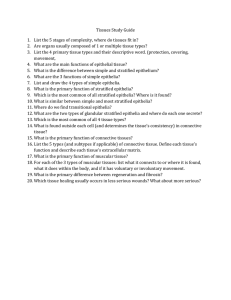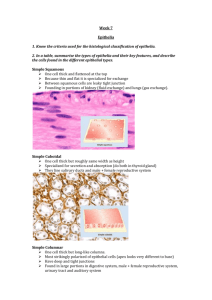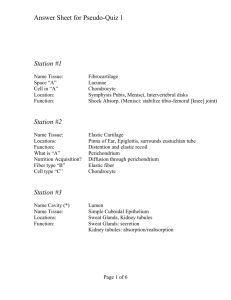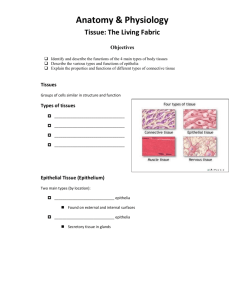Epithelial Tissues
advertisement
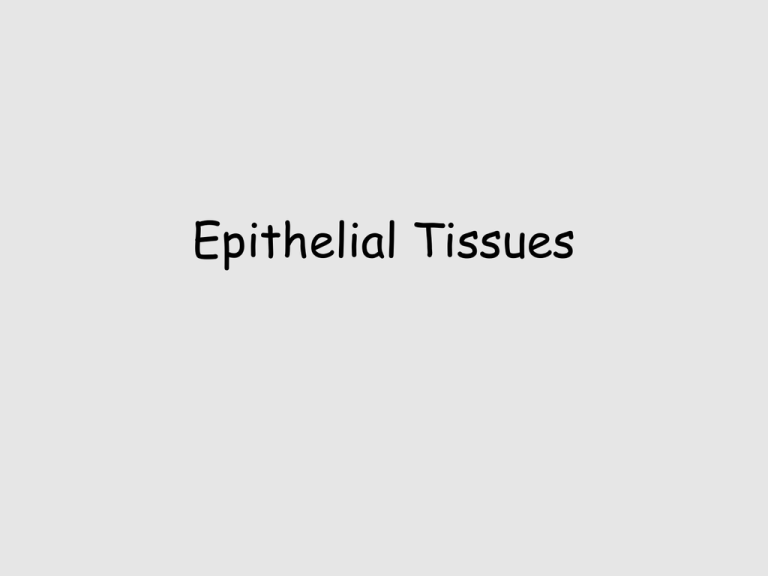
Epithelial Tissues 4 Types of Tissue • • • • Epithelial Connective Muscle Neural • Can you come up with 2-3 basic functions for each of these? Characteristics of Epithelia 1. Predominantly made of cells • 2. 3. 4. 5. all cells tightly bound by cell junctions Polarity (apical and basal surfaces) Attached to basal lamina Avascular (lack blood vessels) Regenerate via stem cells Where is Epithelia found? • Covers exposed surfaces – Skin, digestive tube, reproductive tract, ureter, bladder, trachea, lungs • Lines internal passageways – Blood vessels, lymph system • Forms glands – Sebaceous (mammary), salivary, gastric, intestinal, mucous Functions of Epithelia 1. 2. 3. 4. Provide Physical Protection Control cell permeability Provide sensation - neuroepithelia Produce secretions via glands Functions of Epithelia • Physical Protection – Protect all surfaces exposed to the environment (external & internal) – Mechanical (abrasion) – Biological & chemical (bacteria, viruses & their byproducts) – Dehydration Functions of Epithelia • Control cell permeability – absorption – Anything entering or leaving body crosses epithelia – Sensitive to various stimuli • PTH - increase Ca2+ absorption across epithelial cells of small intestine • Aldosterone - increases Na+ absorption across epithelia of LOH • Vitamin C – promotes iron absorption in small intestine Functions of Epithelia • Provide sensation - neuroepithelia – Large sensory nerve supply – mechano, electro, chemoreceptors – All special senses provided by specialized epithelia Functions of Epithelia • Form glands (glandular epithelia) that produce secretions – Exocrine - released onto epithelial surface via ducts • sweat, tears, milk – Endocrine - released into blood or lymph for action elsewhere • Hormones • ductless – What is the difference between exocrine and endocrine glands & secretions? Where and how they DELIVER those secretions Specialized for different functions 1. Move fluids over the epithelium • Protection & lubrication (mucus) 2. Move fluids through the epithelium • permeability 3. Produce secretions • Protection, messengers, waste removal, nutrient supply Mechanical & Chemical Barriers • Physical integrity is maintained by: – intercellular connections – attachment to basal lamina – maintenance and repair Intercellular Connections • Support • Communication Large Connections • CAMs (cell adhesion molecules): – Transmembrane proteins: cell membrane-cell membrane connections • Intercellular cement: – Proteoglycans (extracellular polysaccharides linked by polypeptide chains) • Glycosaminoglycans • Hyaluronan 3 Cell Junctions • Form bonds with other cells or extracellular material: – tight junctions – gap junctions – desmosomes Tight Junctions • Between 2 cell membranes • Adhesion belt attaches to terminal web • Prevents passage of water & its solutes – Acids – ingested Bacteria – EX: Isolates waste & metabolic byproduct throughout lumen Desmosomes • CAMs, dense areas, and intercellular cement • Button desmosomes – Ties cells together – Supported internally by intermediate filaments; Allow bending and twisting • Hemidesmosomes – Ties cell to basal lamina Attachment to Basal Lamina • Lamina lucida (closer to ET): – thin layer – secreted by epithelia – barrier to proteins • Lamina densa (closer to CT): – thick fibers – Secreted by connective tissue – strength and filtration Repairing & Replacing Epithelia • Epithelial cells are replaced by division of germ cells (stem cells) • Lie just superior to basal lamina Cell Arrangements • Simple: http://as.clayton.edu/biology/biol1151L/lab03/lab_3.htm – Single layer of cells = fragile – Often used for filtration = secretions & absorption • Stratified – 2 or more layers of cells – Use top layer to identify (as squamous, cuboidal etc.) – Often seen in ‘wear and tear’ areas (high mechanical or chemical stress) • Pseudostratified – One layer that looks like many layers – Seen in areas needing to stretch (bladder walls) Classes of Epithelia • Based on shape and # of layers Table 4–1 • Apical • Basal • Basement Membrane – basal lamina: collagen, laminin, proteoglycans • Epithelial secretions – reticular lamina: reticular fibers, fibronectin, glycoproteins • connective tissue secretions Surfaces Surface Variations • Plain • Cilia – Propel substances over surfaces • Microvilli – Increase exposed surface area – Often in columnar epithelia Modes of Glandular Secretion • • • • What is lost during secretion? Apocrine Merocrine Holocrine Merocrine Secretion • Secretory products secreted via vesicular exocytosis – Most common form of secretion – often continuous – Ex: Pancreatic cells, sweat, saliva Figure 4–6a Apocrine Secretion • Cytoplasm & secretion are excreted – milk & underarm persperation Figure 4–6b Holocrine Secretion • Entire cell lost with secretion. – Stem cells divide to replace lost cells – Ex: Sebaceous glands Figure 4–6c Glands: Arrangement of cells • Unicellular: – Goblet cells • Multicellular: – Tubular – Brunner’s gland in duodenum – Alveolar – Sebaceous/Oil glands – Combination – Salivary glands • Mucous = mucin: – A glycoprotein that combines with water Secretory Glands: General Types • Serous – Secrete a watery substance containing enzymes • Saliva with alpha-amylase • Mucous – Secrete mucin • hydrates to form mucus • Mixed Exocrine
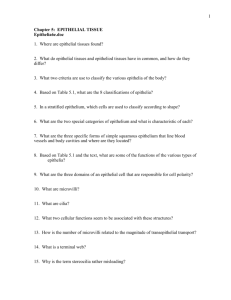
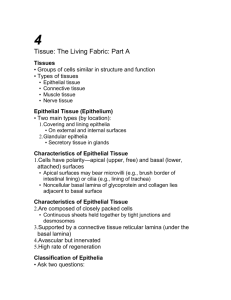
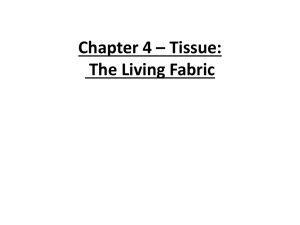
![Histology [Compatibility Mode]](http://s3.studylib.net/store/data/008258852_1-35e3f6f16c05b309b9446a8c29177d53-300x300.png)
